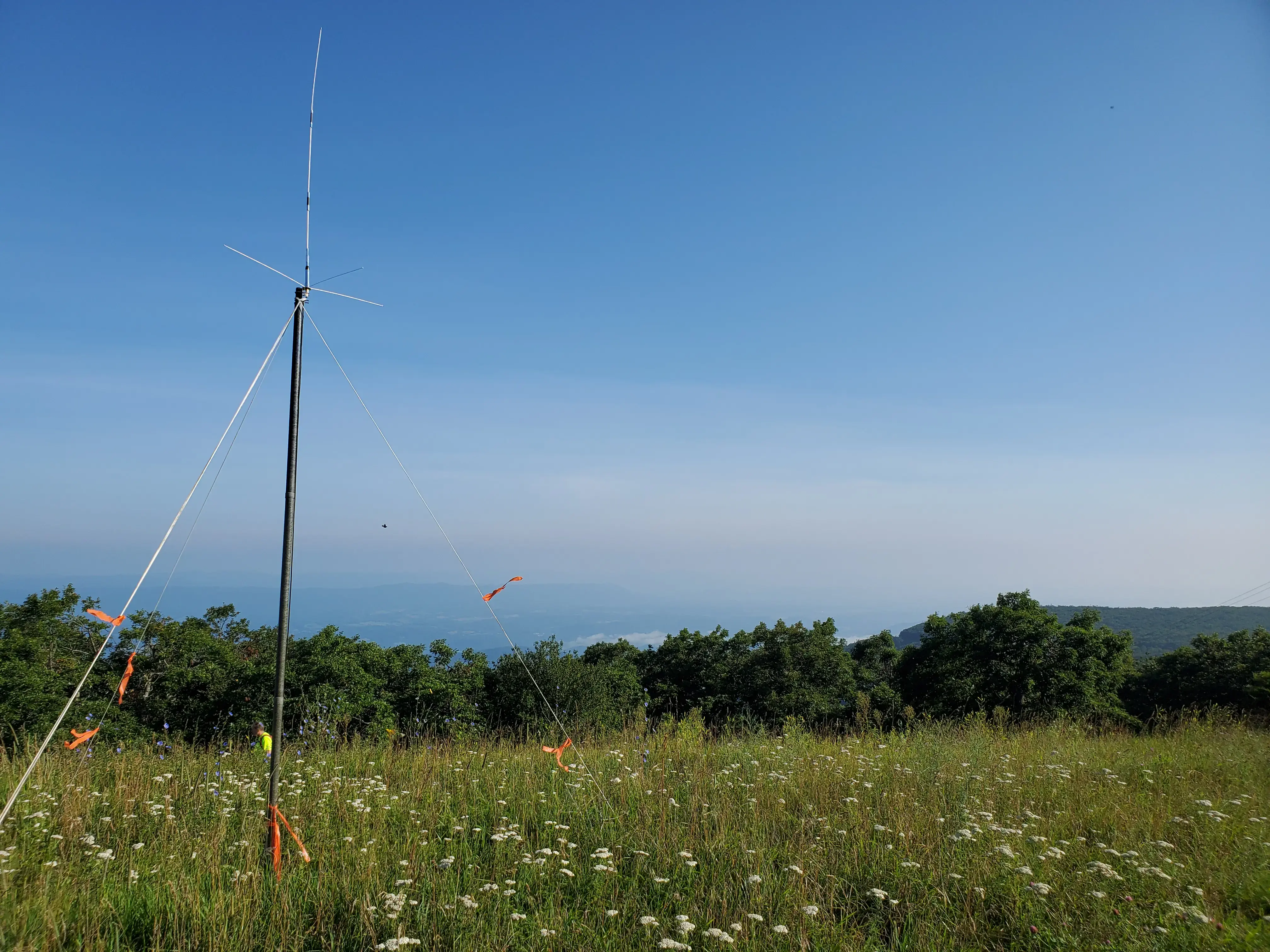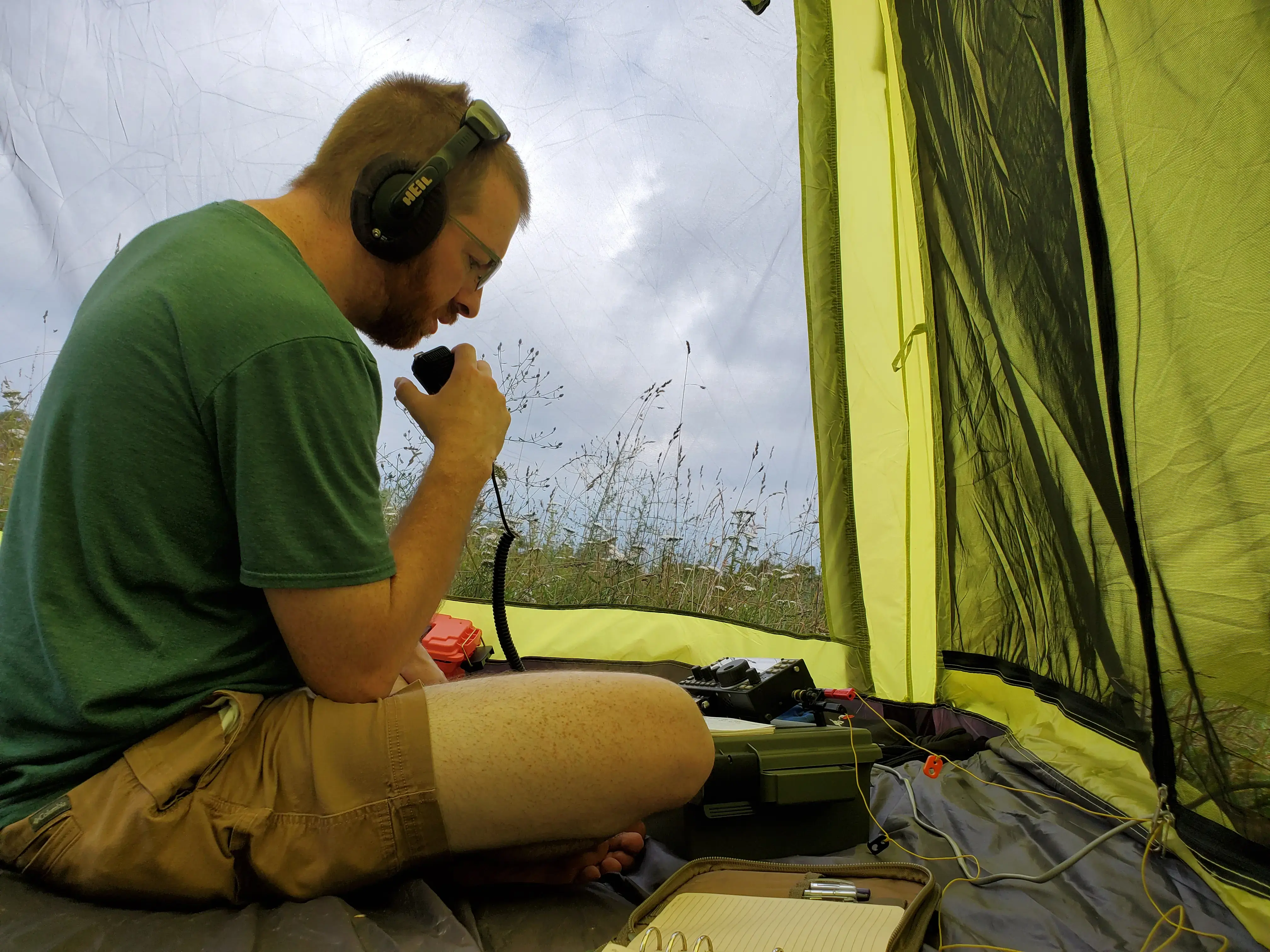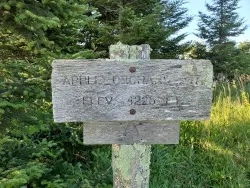Stats
-
When: 2019-07-19 and 2019-07-20
-
Where: Apple Orchard Mountain - W4V/RA-001
-
Who: Eric WG3K, Amanda KI4IWS, Harlan, and Elise
-
Ascent: 280ft in .58mi (3928ft to 4208ft)
-
Equipment: Elecraft KX3, SOTABEAM Bandspringer Midi antenna, Kenwood D700A, Opek HVU-500
-
APRS Coverage: Excellent with nearby I-Gate. Use path WIDE2-1 on your HT when up here to reduce interference and unneeded repeats.
The mission
Each year, several amateur radio operators make the hike (or drive if you’re lucky) to a pre-determined mountain summit along the Appalachian Trail (AT) to create an ad-hoc packet network based on the APRS protocol. This "event" is titled, simply, the APRS Golden Packet Event. From Springer Mountain in Georgia to Mount Katahdin in Maine, (and now we’re including some summits in Canada as well!) we create a digital network comprised of fourteen digipeaters that can be used to pass along positions and messages along the AT. AO Mountain is station five in the network and links Comers Rock with Hawksbill Mountain, each just more than 100 miles (161 kilometers) in distance.
The team
In years past, I’ve been accompanied by some experienced operators that made such a trip enjoyable and easy. In 2016 I was joined by Steve N3IPN and Dave KB3RAN on what ended up being a big learning experience of what not to do when climbing AO Mountain. Too much heavy stuff ended up on that trip which led to a re-evaluation of what we really needed to bring on these trips. In 2017 we added Ed KC3EN to the group and lightened our load a bit. Many feet make light work, especially when you decide not to bring so much junk with you.
This year was a bit different. The people I asked were on travel or were otherwise engaged. I was planning on doing this trip solo when, at the last minute, my family decided to join me. Elise hadn’t really been camping before and Harlan hadn’t been truly camping outside of a campground so I figured it was about time to get them out into nature.
Staying there

This year we made camp at the summit. Besides the industrial complex that has been constructed at the top, much of the summit area is natural, green, and pretty. The paved road makes it easy, well easier, to get up to the summit with lots of stuff. Camping at the top is awesome with clear, starlit skies, and a nice breeze blowing around.
APRS Golden Packet
Since we camped at the summit there was no rush to set up the digipeater and make sure everything would be up and running prior to the event. In fact, I was able to get the system up and running, by myself, in just a few minutes.
 This year I used a different antenna setup that yielded excellent results.
Instead of a base station antenna, as I’ve tried in the past, I used an Opek HVU-500 mobile antenna for 6m, 2m, and 70cm.
Coupled with an MFJ-1401 antenna ground plane kit, used for converting mobile antennas into base antennas, along with three fiberglass mast pipes each measuring 1.13m in length, the Opek did a fantastic job and was much easier to haul around and was still lightweight.
This setup will definitely go into my portable setup.
This year I used a different antenna setup that yielded excellent results.
Instead of a base station antenna, as I’ve tried in the past, I used an Opek HVU-500 mobile antenna for 6m, 2m, and 70cm.
Coupled with an MFJ-1401 antenna ground plane kit, used for converting mobile antennas into base antennas, along with three fiberglass mast pipes each measuring 1.13m in length, the Opek did a fantastic job and was much easier to haul around and was still lightweight.
This setup will definitely go into my portable setup.
I’m continuing to use my LiFePO4 battery. This year I added a 18-watt solar panel to help extend my battery’s capacity. The solar charger, unfortunately, failed at some point in middle of operations and I didn’t realized it until I had been operating HF off of the battery for a while. Fortunately, the charger started working later in the mission but only generated enough to keep the voltage up when the sun came out from behind the clouds.
Signals and operations
Signals between AO Mountain and Hawksbill Mountain have traditionally been the weak link in the Golden Packet network. I figured out my first year that antenna placement is very important on the summit. If this were my land I think I’d put in a survey marker at the spot to make sure I can come back to the exact same spot each time.
Signals, compared to years past, were great going both north and south. I never heard Hawksbill on UHF voice but I copied their packets on VHF with no problem. Comer’s Rock has never been a problem and I chatted regularly with KJ4OAP throughout the day.
One thing that seemed annoying to me was when we were trying to complete Golden Packet exchange, I was losing power, and all the digipeaters in between were sending their position reports. Each report that went through my station drained my battery a little bit more. So instead of being there for the Golden Packets, I was being killed by extra traffic. And that damned cloud wouldn’t move out of the way to help charge my battery! But, in the end, the cloud moved, the station stabilized, and we moved on to complete the pass.
After passing the Golden Packet each way at 1200 baud, we switched to 9600 baud and completed the same Golden Packet in just a few minutes. 9600 baud apparently doubles the ALOHA channel capacity and also seems to do better along some of our weaker paths. I saw no problems at AO Mountain.
Summits on the Air (SOTA)
 As usual, I brought my Elecraft KX3 along with my SOTABEAMS Bandspringer Midi antenna and 4.1m fiberglass pole.
The antenna continues to perform well and is the easiest and fastest antenna I’ve found to erect for HF.
As usual, I brought my Elecraft KX3 along with my SOTABEAMS Bandspringer Midi antenna and 4.1m fiberglass pole.
The antenna continues to perform well and is the easiest and fastest antenna I’ve found to erect for HF.
I started at 60m and went to 20m putting stations in the log on every band I stopped in. There is really awful noise up at the top of the summit that has rendered my Elecraft K1 useless in previous trips. This noise was back and got worse the higher in frequency I went. I really wanted to do more CW but my filters just weren’t taking out the noise and it was difficult to pick out the stations. I, unfortunately, ended up with only one CW contact, which was a disappointment. With my power budget very low, I ended HF operations early to keep power for the primary mission.
I did manage fourteen contacts on five bands during the operational period and thank AB4PP, KG3W, W2SE, NE4TN, K2JB, KB1RJD, KI4TN, AA4IT, K1LIZ, W5GAI, KJ4OAP, and W5ODS for answering my calls.
Summary
Overall, the operation was a success both personally and for the Golden Packet team. I need to do more testing to figure out what happened with my solar charger but I feel that everything else went well. We’ll see what next year holds.
